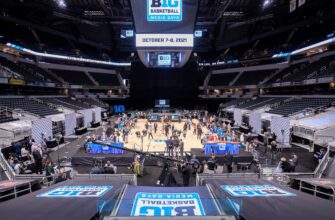As the dust settles on what has been widely described as one of the most unpredictable NBA offseasons in recent memory, a mid-July report card feels not just appropriate, but essential. The 2025 market, heavily influenced by the new Collective Bargaining Agreement (CBA) and the palpable fear of breaching its stringent salary aprons, has seen more strategic maneuvers than splashy free-agent signings. It’s a nuanced landscape where success isn`t just measured by who you acquired, but by how deftly you navigated the financial tightrope. And yes, some teams walked it with grace, while others, shall we say, stumbled into the abyss.
- The Anomalous Market: A CBA Conundrum
- The Architects of Success: Teams That Thrived
- Houston Rockets: A Galactic Leap?
- Orlando Magic: Building a Modern Powerhouse
- Denver Nuggets: The Quiet Masters of Stability
- The Stumbling Blocks: Teams That Fell Short
- Milwaukee Bucks: A Disorienting Cut
- Los Angeles Lakers: Stuck in the Mud?
- Golden State Warriors: Fading Glory?
- The Unclaimed Jewels: A Market Still in Motion
The Anomalous Market: A CBA Conundrum
This year’s market was less a frantic sprint for marquee names and more a calculated chess match. The new CBA, with its punitive luxury tax tiers and restrictions on future team-building, has forced front offices to re-evaluate every contract, every trade chip. The `second apron` looms like a fiscal guillotine, making teams wary of even minor transgressions. This environment explains the relative scarcity of conventional blockbuster free-agent moves and the proliferation of complex multi-team trades designed to shed salary or acquire assets without incurring crippling penalties. It`s a fascinating, if sometimes frustrating, evolution of the league`s economic structure, proving that even in professional sports, accountants often wield more power than power forwards.
The Architects of Success: Teams That Thrived
In a market where caution was the watchword, a few teams managed to not only survive but truly flourish, making moves that significantly alter their trajectories.
Houston Rockets: A Galactic Leap?
The consensus top marks go to the Houston Rockets, a team that has decisively shed its rebuilding label. Their crowning achievement? The acquisition of Kevin Durant. While the exact details of how they orchestrated this coup within the confines of the new CBA remain a masterclass in financial alchemy, the outcome is undeniable. Pairing Durant with their promising young core elevates Houston from an intriguing prospect to a legitimate contender. It’s a move that signals a clear intent to win now, sacrificing long-term flexibility for immediate championship aspirations. A calculated risk, certainly, but one that has clearly paid dividends in perceived market success. The question remains: can they truly coalesce into a contender or will the star power prove to be a double-edged sword?
Orlando Magic: Building a Modern Powerhouse
Close behind Houston, the Orlando Magic have quietly — yet effectively — transformed their roster. The reported acquisition of Desmond Bane provides a much-needed injection of elite perimeter scoring and shooting, complementing their established young frontcourt. Orlando`s strategy appears to be a shrewd combination of developing homegrown talent and adding established, high-impact players who fit their timeline. Their moves reflect a clear vision for a versatile, modern NBA roster, avoiding the pitfalls of overspending while still significantly improving. They`ve built something sustainable, which in this league, is almost as rare as a unicorn sighting.
Denver Nuggets: The Quiet Masters of Stability
While perhaps not as flashy as the Rockets or Magic, the Denver Nuggets deserve praise for their understated yet highly effective market period. In an era where champions often find their rosters picked apart, Denver managed to retain crucial pieces and make astute, low-cost additions that deepen their rotation without jeopardizing their financial future. Their ability to maintain competitive excellence and continuity in a volatile market speaks volumes about their front office`s strategic foresight. Sometimes, the best moves are the ones that prevent regression, which is far less exciting for headlines but infinitely more effective for banner-raising.
The Stumbling Blocks: Teams That Fell Short
Conversely, some perennial contenders and high-profile franchises found themselves struggling to adapt, making moves that raised more questions than answers.
Milwaukee Bucks: A Disorienting Cut
The Milwaukee Bucks` market performance has left many scratching their heads. The decision to cut Damian Lillard, a superstar talent only recently acquired, sends a perplexing message. While the financial implications of his contract under the new CBA were undoubtedly a factor, the optics and potential on-court regression are concerning. It suggests a severe miscalculation in asset management or a drastic philosophical shift. For a team with championship aspirations, this move feels like a step backward, leaving fans to wonder about the long-term plan. Perhaps they’re playing three-dimensional chess, but to the rest of us, it looks like checkers gone wrong.
Los Angeles Lakers: Stuck in the Mud?
The Los Angeles Lakers, perennially under the microscope, find themselves in the `bocciati` (rejected) category this offseason. Despite their constant pursuit of star power, their inability to make significant, needle-moving acquisitions, coupled with the departure of key role players, raises serious questions about their roster construction for the upcoming season. It seems the new CBA has finally put a damper on their usual `superstar or bust` approach, leaving them in a challenging position with limited flexibility. One might even suggest their market strategy was less `Hollywood Blockbuster` and more `Direct-to-Video Release`—a brave choice, perhaps, but one rarely met with critical acclaim.
Golden State Warriors: Fading Glory?
The Golden State Warriors, another team accustomed to being at the top, have also had a disappointing market. Their inability to either revitalize their aging core with meaningful additions or strategically offload high-salary contracts to reset for the future has left them in an awkward limbo. The financial constraints imposed by the new CBA hit hard here, making it difficult to navigate veteran salaries while still competing. The era of dynasty often ends not with a bang, but with the subtle whimper of a stalled free agency, leaving fans to ponder the inevitable march of time and salary caps.
The Unclaimed Jewels: A Market Still in Motion
Despite the mid-July assessment, the market isn`t entirely settled. A surprising number of high-profile, talented players remain unsigned, reflecting the ongoing strategic dance influenced by the CBA. These players represent a potential final ripple in the offseason tide:
- Josh Giddey and Jonathan Kuminga: Intriguing young talents with considerable upside, their next landing spots could define future contender status.
- Chris Paul, Russell Westbrook, and Malcolm Brogdon: Veterans who still offer valuable contributions, albeit perhaps at a reduced rate or in a different role. Their experience could be invaluable to a contender looking for a final piece.
- Damian Lillard: Cut loose by Milwaukee, his next destination remains the biggest unsolved puzzle of this peculiar offseason. His eventual landing spot will undoubtedly reshape the landscape further, adding a final, unpredictable chapter to this anomalous market saga.
This 2025 NBA offseason will be remembered less for its traditional fireworks and more for its intricate, often frustrating, strategic chess matches. It`s a testament to the league`s ever-evolving financial rules and the ingenuity (or sometimes, desperation) of its front offices. While some teams have clearly found their footing, others are left scrambling, proving that in the modern NBA, sometimes the biggest victory isn`t landing a star, but simply surviving the new economic reality with your cap sheet intact. The basketball world eagerly awaits the tip-off, not just to see the new rosters in action, but to truly understand the long-term ramifications of this fascinating, finance-driven summer.







